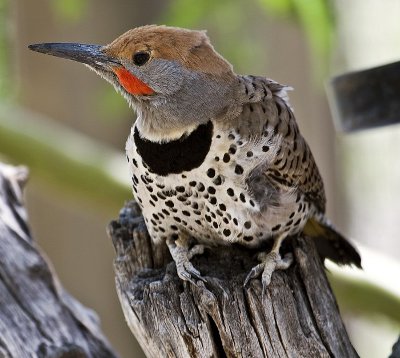Gilded Flicker Woodpeeker
Category: Woodpeckers

Facts about Gilded Flicker Woodpeekers, "Scientific name for Gilded Flicker Woodpecker is Colaptes chrysoides". Gilded Flicker Woodpeeker is a Colaptes type of woodpecker that comes from the Picidae family. "Scientific name for Woodpecker Picidae". Gilded Flicker Woodpeckers are birds in the Class of "Aves".
The Gilded Flicker Woodpeckers are native to the southwestern parts of the United States and northwestern part of Mexico, and the Gilded Flicker Woodpecker are largely found in the saguaro cactus woodlands of the Sonoran Desert. The Gilded Flicker woodpecker can be easily distinguished from other varieties by its under-wings, which are golden yellow in color. The Gilded Flicker are one among the biggest woodpeckers in the Picidae family. The Gilded Flicker Woodpeckers are considered a permanent inhabitant all through their range, with only little, local wandering movements.
Features
The Gilded Flicker Woodpecker is a large-sized woodpecker, with a body length of 11 inches (27.9 cm) and the wingspan of 18 29/32 inches (48 cm). They have a body mass that ranges from 3.2 pounds to 4.6 pounds (1.45 to 2 kg).
The back part of the Gilded Flicker Woodpecker is light brown in color, with horizontal, black color barring. The breast of the bird features a big, black color crescent, and the brown to whitish undersides are found with black color spots. The Gilded Flicker Woodpecker has a brown-colored cap and a light, white rump that can be seen during the flight. The juvenile Gilded Flicker Woodpeckers resemble the adults, but have a dull body color. The male Gilded Flicker can be differentiated from the female by the existence of a red moustache.
Mostly, the Gilded Flicker woodpecker constructs its nest hole in an imposing saguaro cactus, digging up the nest hole closer to the top than the land. The cactus protects itself against water failure into the hollow space of the nesting hole by secreting juice that hardens into a water-resistant structure. Occasionally, the Gilded Flicker Woodpeckers hybridize with northern flicker woodpeckers in the narrower regions where their habitat and range overlap.
Diet
Gilded Flicker woodpeckers are ground-foragers, and they spend much of their day in probing anthills and locating other insects, nectar and pollen. The Gilded Flicker Woodpecker lone, non-migratory birds feed mostly on insects, particularly ants. These woodpeckers consume more ants than any other bird varieties in North America.
Male and female Gilded Flicker Woodpeckers are able to drum hollow trees logs execrate. Since woodpeckers do not have vocal cords and don't sing, this pecking activity also plays an important role in communicating with each other. Gilded Flicker Woodpeckers drumming is also to attract a mate, mark out territory, both sexes are known to drum.
An average Gilded Flicker Woodpeckers tongue is up to 4 inches long. The length can be a little different depending on which species of woodpecker. The Gilded Flicker Woodpecker tongue wraps around the reinforced skull structured and squashy bone, to even out the impact of the pecking force. Many Gilded Flicker Woodpeckers have barbed tongues that helps them remove bugs from holes and tree bark.
Feathers that look like hairs on the Gilded Flicker Woodpecker nostrils, prevent ingestion of wood particles.
The face of the Gilded Flicker Woodpecker breed is gray in color with the red color mustache. There are unique golden yellow color markings below their wings and tail, which have given the Woodpecker the name as Gilded Flicker. The brilliant shaft is observable on the under-surface of their wings, and the Gilded Flicker Woodpecker will flash these multicolored under-wings at prospective companions during courtship and at competitors while protecting territories.
When feeding, drumming and building a nest cavity, a Gilded Flicker Woodpecker can peck up to 20 times per second, wow that's fast! or a total between 9,000 and 12,000 pecks in a day.
Gilded Flicker Woodpeckers have a prominent surge in flight comprise of three rapid wing flaps, followed by a quick glide when the woodpeckers wings are tucked against its body rather than spread out like many other birds.
The average life span of a Gilded Flicker Woodpecker in the wild is 8 to 12 years, depending on the species and environment
Gilded Flicker Woodpeckers are omnivores; meaning - an animal that eats food of both animal and plant and origin.
Gilded Flicker Woodpeckers are monogamous meaning- the pair will mate for lifetime. Both male and female prepare the nest in the tree for babies and both will help feed them. The female Gilded Flicker Woodpecker will lay between 3 and 5 eggs and the incubation period will lasts 11 to 14 days. After one month of hatching, young Gilded Flicker Woodpeckers will leave the nest and venture out on there own.
Gilded Flicker Woodpeckers possess a protective ocular mechanisms for protecting its eyes from shaking from the pecking impact. Gilded Flicker Woodpeckers show a restricted axial globe movement due to the tight fit within the fascial tissue connections and orbit between the sclera and orbital rim.
The eyes of the Gilded Flicker Woodpecker are covered with a nictitating membrane (from Latin nictare, to blink)— a translucent and transparent third eyelid - that protects the Gilded Flicker Woodpeckers eyes from flying debris while pecking. There are more than 190 species of woodpeckers worldwide, but none of them are found in polar regions, Madagascar, New Zealand or Australia.
Most Gilded Flicker Woodpeckers have zygodactyl feet, having 4 fingers, which means they have two toes facing the front and two toes facing the back, that helps the Gilded Flicker Woodpecker to have a strong grip on trees vertically. The Gilded Flicker Woodpecker use these 8 fingers with their stiff central portion tail feathers to brace on trees as they climb.

 Back To Category Woodpeckers
Back To Category Woodpeckers